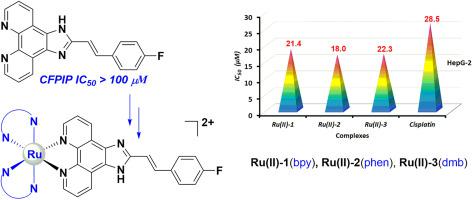Journal of Inorganic Biochemistry ( IF 3.9 ) Pub Date : 2021-09-20 , DOI: 10.1016/j.jinorgbio.2021.111616 Guang-Bin Jiang 1 , Wen-Yao Zhang 2 , Miao He 2 , Yi-Ying Gu 2 , Lan Bai 2 , Yang-Jie Wang 2 , Qiao-Yan Yi 2 , Fan Du 2

|
Ruthenium-containing complexes have emerged as good alternative to the currently used platinum-containing drugs for malignant tumor therapy. In this work, cytotoxic effects of recently synthesized ruthenium polypyridyl complexes [Ru(bpy)2(CFPIP)](ClO4)2 (bpy = 2,2′-bipyridine, CFPIP = (E)-2-(4-fluorostyryl)-1H-imidazo[4,5-f][1,10]phenanthroline, Ru(II)-1), [Ru(phen)2(CFPIP)](ClO4)2 (phen = 1,10-phenanthroline, Ru(II)-2) and [Ru(dmb)2(CFPIP)](ClO4)2 (dmb = 4,4′-dimethyl-2,2′-bipyridine, Ru(II)-3) toward different tumor cells were investigated in vitro and compared with cisplatin, the most widely used chemotherapeutic drug against hepatocellular carcinoma (HepG-2). The results demonstrate that target complexes show excellent cytotoxicity against HepG-2 cells with low IC50 value of 21.4 ± 1.5, 18.0 ± 2.1 and 22.3 ± 1.7 μM, respectively. It was important noting that target Ru(II) complexes exhibited better antitumor activity than cisplatin (IC50 = 28.5 ± 2.4 μM) against HepG-2 cells, and has no obvious toxicity to normal cell LO2. DNA binding results suggest that Ru(II)-1, Ru(II)-2 and Ru(II)-3 interact with CT DNA (calf thymus DNA) through intercalative mode. Complexes exerted its antitumor activity through increasing anti-migration and inducing cell cycle arrest at the S phase. In addition, the apoptosis was tested by AO (acridine orange)/EB (ethidium bromide) staining and flow cytometry. Mitochondrial membrane potential (MMP), reactive oxygen species (ROS), and colocalization tests were also evaluated by ImageXpress Micro XLS system. Overall, the results show that the ruthenium polypyridyl complexes induce apoptosis in HepG-2 cells through ROS-mediated mitochondria dysfunction pathway.
中文翻译:

三种钌多吡啶基配合物抗肿瘤活性的系统评价
含钌配合物已成为目前用于恶性肿瘤治疗的含铂药物的良好替代品。在这项工作中,最近合成的多吡啶钌配合物 [Ru(bpy) 2 (CFPIP)](ClO 4 ) 2 (bpy = 2,2'-bipyridine, CFPIP = ( E )-2-(4- fluorostyryl) 的细胞毒作用-1 H-咪唑并[4,5- f ][1,10]菲咯啉, Ru(II)-1 ), [Ru(phen) 2 (CFPIP)](ClO 4 ) 2 (phen = 1,10-菲咯啉, Ru(II)-2 ) 和 [Ru(dmb) 2 (CFPIP)](ClO 4 ) 2(dmb = 4,4'-dimethyl-2,2'-bipyridine, Ru(II)-3 ) 在体外研究了对不同肿瘤细胞的作用,并与最广泛使用的肝细胞癌化疗药物顺铂 (HepG-2 )。结果表明,靶标复合物对 HepG-2 细胞具有优异的细胞毒性,IC 50值低,分别为 21.4 ± 1.5、18.0 ± 2.1 和 22.3 ± 1.7 μM。值得注意的是,靶Ru(II)复合物对HepG-2细胞的抗肿瘤活性优于顺铂(IC50 = 28.5 ± 2.4 μM),对正常细胞LO2无明显毒性。DNA 结合结果表明,Ru(II)-1、Ru(II)-2和Ru(II)-3通过插入模式与CT DNA(小牛胸腺DNA)相互作用。复合物通过增加抗迁移和诱导细胞周期停滞在S期发挥其抗肿瘤活性。此外,通过AO(吖啶橙)/EB(溴化乙锭)染色和流式细胞术检测细胞凋亡。ImageXpress Micro XLS 系统还评估了线粒体膜电位 (MMP)、活性氧 (ROS) 和共定位测试。总体而言,结果表明,多吡啶钌复合物通过 ROS 介导的线粒体功能障碍途径诱导 HepG-2 细胞凋亡。



























 京公网安备 11010802027423号
京公网安备 11010802027423号